Naveen Verma
eViper: A Scalable Platform for Untethered Modular Soft Robots
Mar 03, 2023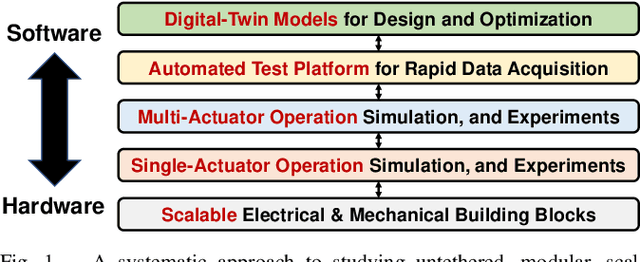
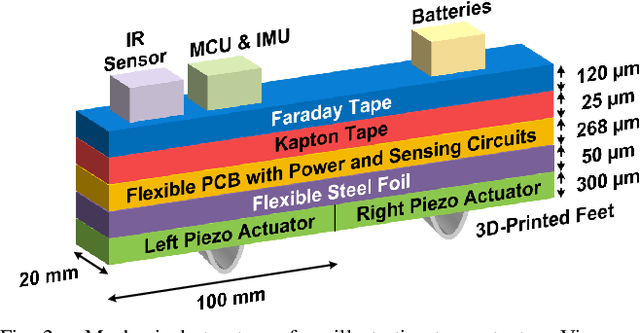


Abstract:Soft robots present unique capabilities, but have been limited by the lack of scalable technologies for construction and the complexity of algorithms for efficient control and motion, which depend on soft-body dynamics, high-dimensional actuation patterns, and external/on-board forces. This paper presents scalable methods and platforms to study the impact of weight distribution and actuation patterns on fully untethered modular soft robots. An extendable Vibrating Intelligent Piezo-Electric Robot (eViper), together with an open-source Simulation Framework for Electroactive Robotic Sheet (SFERS) implemented in PyBullet, was developed as a platform to study the sophisticated weight-locomotion interaction. By integrating the power electronics, sensors, actuators, and batteries on-board, the eViper platform enables rapid design iteration and evaluation of different weight distribution and control strategies for the actuator arrays, supporting both physics-based modeling and data-driven modeling via on-board automatic data-acquisition capabilities. We show that SFERS can provide useful guidelines for optimizing the weight distribution and actuation patterns of the eViper to achieve the maximum speed or minimum cost-of-transportation (COT).
Wirelessly-Controlled Untethered Piezoelectric Planar Soft Robot Capable of Bidirectional Crawling and Rotation
Jul 01, 2022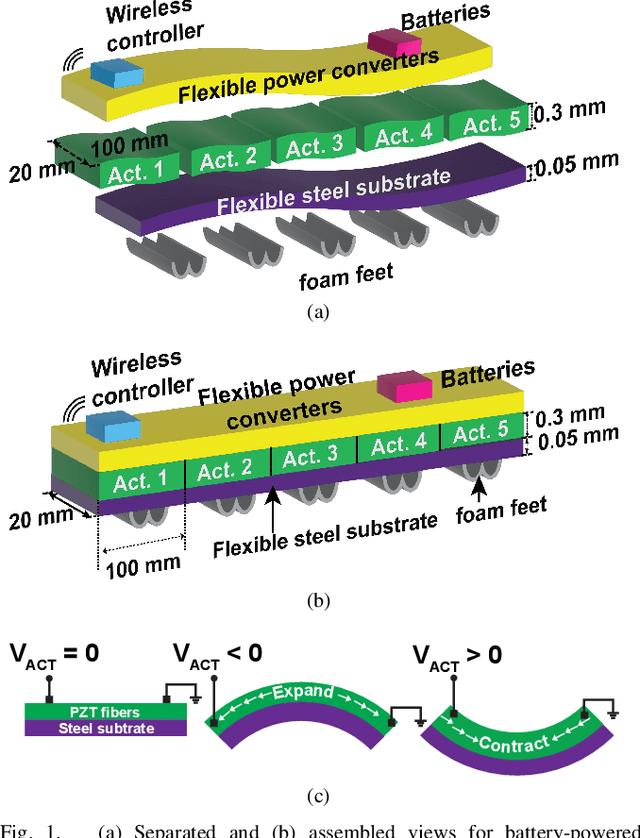
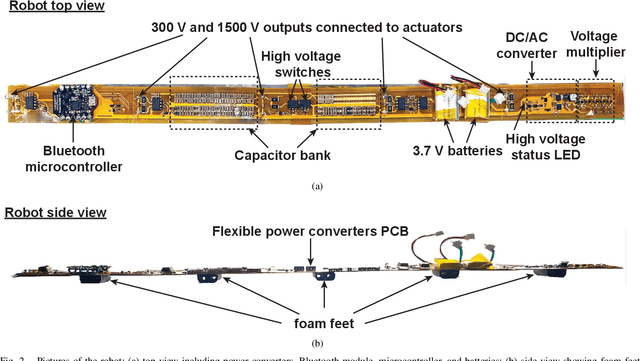
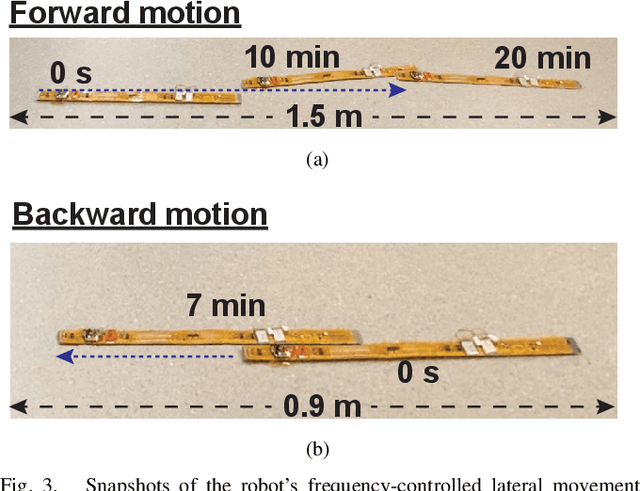
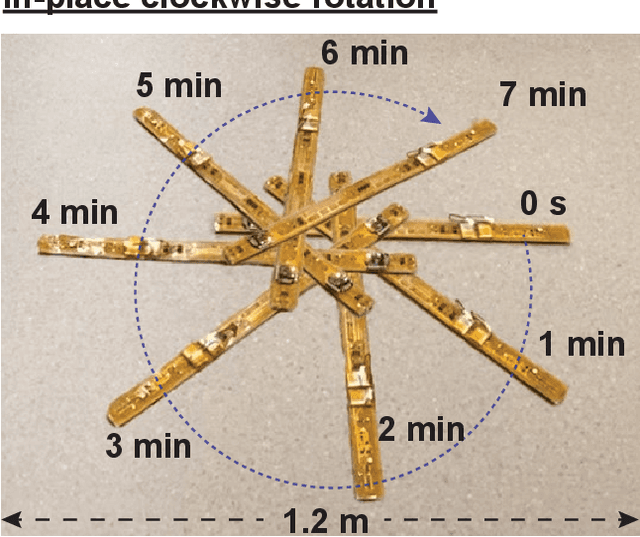
Abstract:Electrostatic actuators provide a promising approach to creating soft robotic sheets, due to their flexible form factor, modular integration, and fast response speed. However, their control requires kilo-Volt signals and understanding complex dynamics resulting from force interactions by on-board and environmental effects. In this work, we demonstrate an untethered two-dimensional five-actuator piezoelectric robot powered by batteries and on-board high-voltage circuitry, and controlled through a wireless link. The scalable fabrication approach is based on bonding different functional layers on top of each other (steel foil substrate, actuators, flexible electronics). The robot exhibits a range of controllable motions, including bidirectional crawling (up to ~0.6 cm/s), turning, and in-place rotation (at ~1 degree/s). High-speed videos and control experiments show that the richness of the motion results from the interaction of an asymmetric mass distribution in the robot and the associated dependence of the dynamics on the driving frequency of the piezoelectrics.
Model-Based Control of Planar Piezoelectric Inchworm Soft Robot for Crawling in Constrained Environments
Mar 29, 2022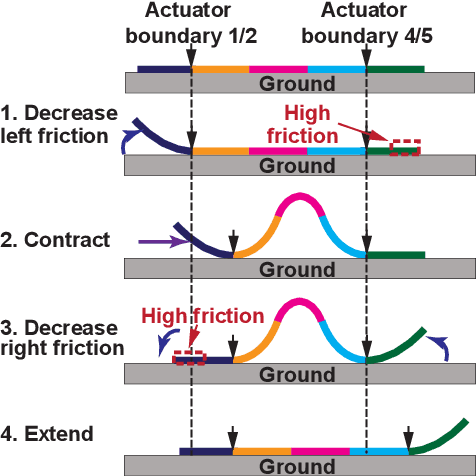
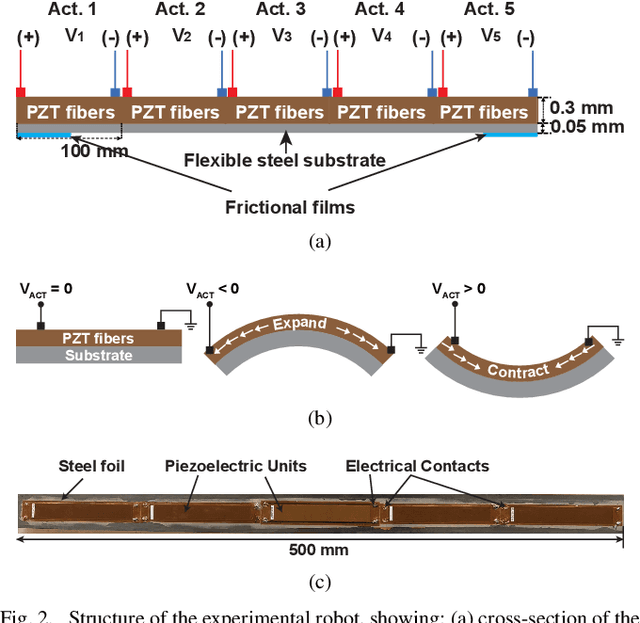
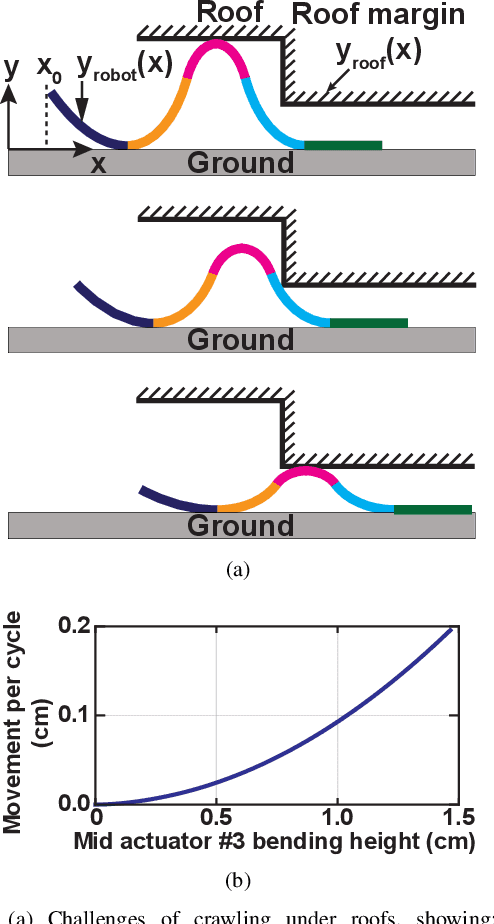
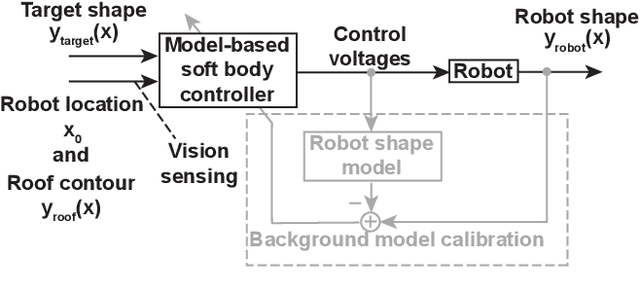
Abstract:Soft robots have drawn significant attention recently for their ability to achieve rich shapes when interacting with complex environments. However, their elasticity and flexibility compared to rigid robots also pose significant challenges for precise and robust shape control in real-time. Motivated by their potential to operate in highly-constrained environments, as in search-and-rescue operations, this work addresses these challenges of soft robots by developing a model-based full-shape controller, validated and demonstrated by experiments. A five-actuator planar soft robot was constructed with planar piezoelectric layers bonded to a steel foil substrate, enabling inchworm-like motion. The controller uses a soft-body continuous model for shape planning and control, given target shapes and/or environmental constraints, such as crawling under overhead barriers or "roof" safety lines. An approach to background model calibrations is developed to address deviations of actual robot shape due to material parameter variations and drift. Full experimental shape control and optimal movement under a roof safety line are demonstrated, where the robot maximizes its speed within the overhead constraint. The mean-squared error between the measured and target shapes improves from ~0.05 cm$^{2}$ without calibration to ~0.01 cm$^{2}$ with calibration. Simulation-based validation is also performed with various different roof shapes.
Scalable Simulation and Demonstration of Jumping Piezoelectric 2-D Soft Robots
Feb 28, 2022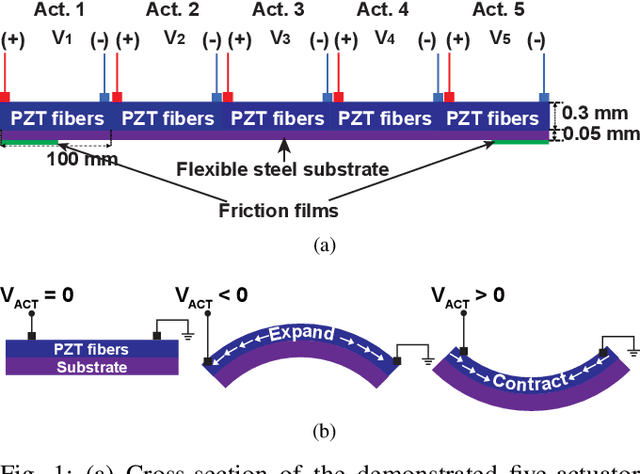
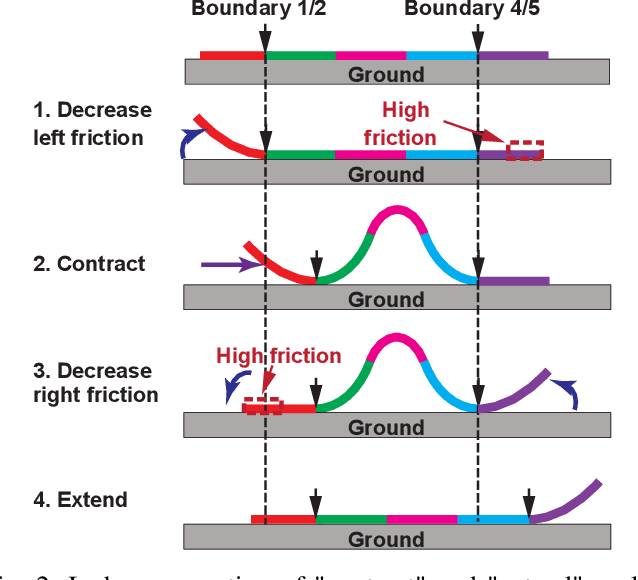
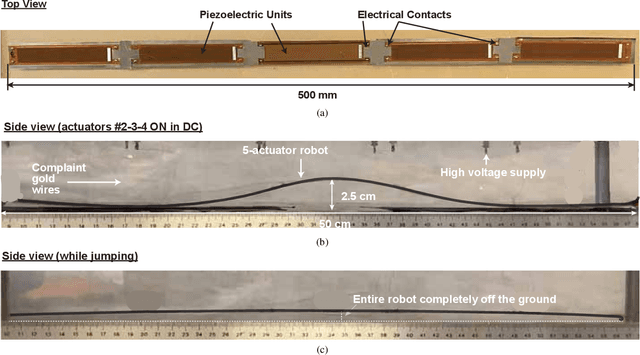
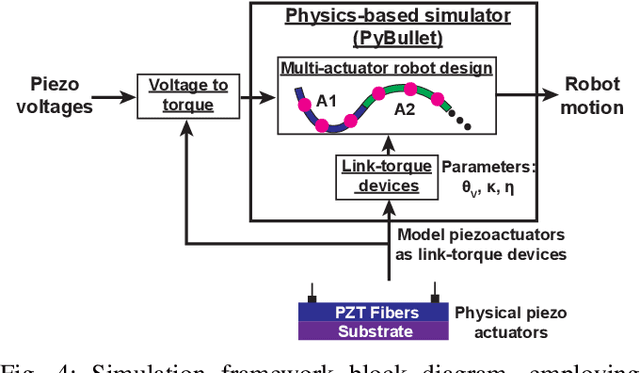
Abstract:Soft robots have drawn great interest due to their ability to take on a rich range of shapes and motions, compared to traditional rigid robots. However, the motions, and underlying statics and dynamics, pose significant challenges to forming well-generalized and robust models necessary for robot design and control. In this work, we demonstrate a five-actuator soft robot capable of complex motions and develop a scalable simulation framework that reliably predicts robot motions. The simulation framework is validated by comparing its predictions to experimental results, based on a robot constructed from piezoelectric layers bonded to a steel-foil substrate. The simulation framework exploits the physics engine PyBullet, and employs discrete rigid-link elements connected by motors to model the actuators. We perform static and AC analyses to validate a single-unit actuator cantilever setup and observe close agreement between simulation and experiments for both the cases. The analyses are extended to the five-actuator robot, where simulations accurately predict the static and AC robot motions, including shapes for applied DC voltage inputs, nearly-static "inchworm" motion, and jumping (in vertical as well as vertical and horizontal directions). These motions exhibit complex non-linear behavior, with forward robot motion reaching ~1 cm/s. Our open-source code can be found at: https://github.com/zhiwuz/sfers.
Piezoelectric Soft Robot Inchworm Motion by Controlling Ground Friction through Robot Shape
Nov 01, 2021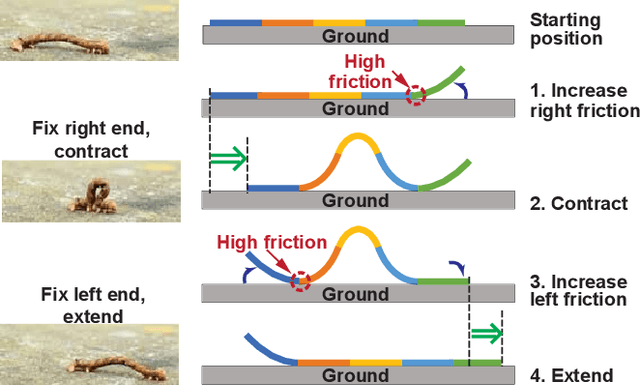
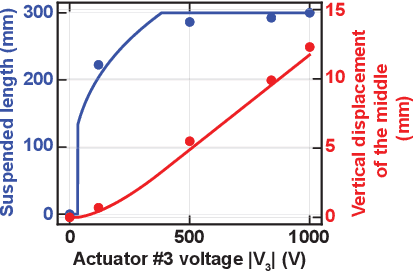
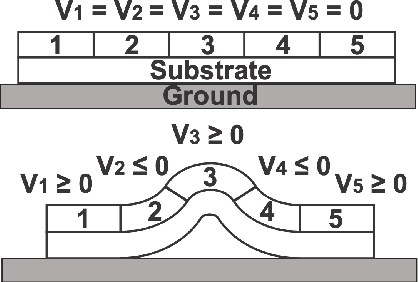
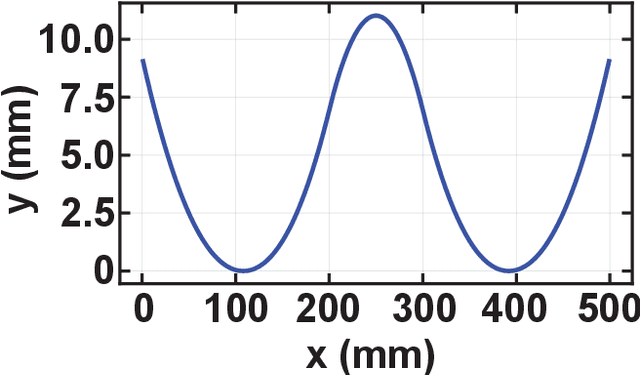
Abstract:Electrically driven soft robots enable small and light bodies, as well as environmental compatibility, various locomotion, and safe operation. In particular, electrostatic actuators (for example, piezoelectric actuators) are fast responded. However, scalable ways for seamless integration and untethered operation remain unclear. In addition, soft body nature modeling, including environmental interactions, is a long-standing challenge. Furthermore, more locomotion mechanisms need to be explored. In this paper, we have designed, modeled, and demonstrated a soft robot that, for the first time, starts to address all these questions. It has a linear array of five actuators in a planar structure, opening doors for integration and free operation. A new inchworm-inspired crawling motion mechanism was designed and validated by relying on posture self-adjustment. The first analytical soft body model including piezoelectricity, gravity, and ground interactions that well explain robot locomotion was developed and validated by experiments. We demonstrated the robot's forward and backward motion and explored the effects of payload and driving speed: 1.2 mm movement per cycle and up to 200 g payload (16x body weight) can be carried while moving. This work paves the way for fast-responding robots in complicated unknown environments.
A Microprocessor implemented in 65nm CMOS with Configurable and Bit-scalable Accelerator for Programmable In-memory Computing
Nov 09, 2018



Abstract:This paper presents a programmable in-memory-computing processor, demonstrated in a 65nm CMOS technology. For data-centric workloads, such as deep neural networks, data movement often dominates when implemented with today's computing architectures. This has motivated spatial architectures, where the arrangement of data-storage and compute hardware is distributed and explicitly aligned to the computation dataflow, most notably for matrix-vector multiplication. In-memory computing is a spatial architecture where processing elements correspond to dense bit cells, providing local storage and compute, typically employing analog operation. Though this raises the potential for high energy efficiency and throughput, analog operation has significantly limited robustness, scale, and programmability. This paper describes a 590kb in-memory-computing accelerator integrated in a programmable processor architecture, by exploiting recent approaches to charge-domain in-memory computing. The architecture takes the approach of tight coupling with an embedded CPU, through accelerator interfaces enabling integration in the standard processor memory space. Additionally, a near-memory-computing datapath both enables diverse computations locally, to address operations required across applications, and enables bit-precision scalability for matrix/input-vector elements, through a bit-parallel/bit-serial (BP/BS) scheme. Chip measurements show an energy efficiency of 152/297 1b-TOPS/W and throughput of 4.7/1.9 1b-TOPS (scaling linearly with the matrix/input-vector element precisions) at VDD of 1.2/0.85V. Neural network demonstrations with 1-b/4-b weights and activations for CIFAR-10 classification consume 5.3/105.2 $\mu$J/image at 176/23 fps, with accuracy at the level of digital/software implementation (89.3/92.4 $\%$ accuracy).
 Add to Chrome
Add to Chrome Add to Firefox
Add to Firefox Add to Edge
Add to Edge